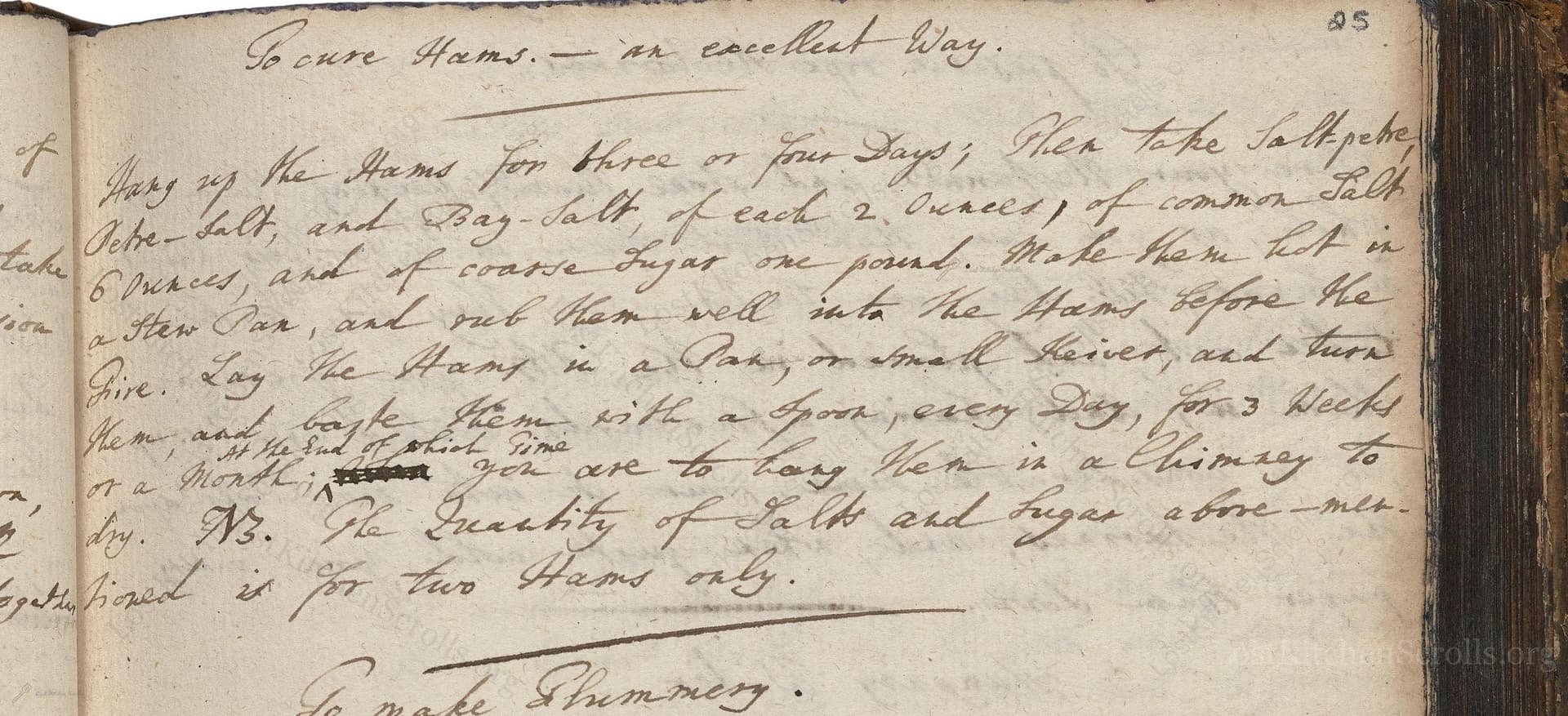To Cure Hams.— An Excellent Way
From the treasured pages of Medicinal recipes compiled by Andrew Slee
Written by Andrew Slee

To Cure Hams.— An Excellent Way
"Hang up the Hams for three or four Days; then take Salt-petre, and Bay-Salt, of each 6 Ounces, and of coarse Sugar one Ounce and a Quarter, and of common Salt 12 Ounces, ground. Make them hot in a Stew Pan, and rub them well in to the Hams before the Fire. Lay the Hams in a Pan, or a small Keiver, and turn them, and baste them with a Spoon, every Day, for 3 Weeks or a Month; and then you are to hang them in a Chimney to dry. NB. The Quantity of Salt and Sugar above-mentioned is for two Hams only."
Note on the Original Text
Seventeenth-century recipes were concise, assuming household knowledge and omitting details like exact sizes or temperatures. Spelling was more variable: 'keiver' refers to a wooden vessel; 'salt-petre' is saltpetre, or potassium nitrate; and 'baste' meant to spoon over or moisten with cure. Ingredients are listed by weight for two hams, a common scale for larger households. Instructions depend on frequent personal attention—turning and basting each day—reflecting both the labor and the rhythms of early modern kitchens.

Title
Medicinal recipes compiled by Andrew Slee (1654)
You can also click the book image above to peruse the original tome
Writer
Andrew Slee
Era
1654
Publisher
Unknown
Background
A delectable glimpse into 17th-century kitchens, this manuscript compiled by Andrew Slee promises an array of historical recipes and culinary secrets sure to delight any gourmand with a taste for the past.
Kindly made available by
Folger Shakespeare Library
This recipe hails from mid-17th century England, a time before refrigeration, when salting and drying were essential means to preserve meat through winter months. Collected by Andrew Slee in 1654, the technique reflects practical domestic economy as practiced in households of means, who would cure several hams after each autumn's pig slaughter. Use of ingredients like saltpetre (then common) showcases period understanding of both food safety and flavor, while the mention of bay salt hints at trade connections for specialty salts via port cities. These preservation techniques would allow the ham to last for months, providing a vital protein source in leaner seasons.

Back then, hams would be hung from hooks in a pantry, larder, or chimney. A shallow tub, wooden keiver (a large round vessel), or a deep tray held the hams during cure. Tools included a pestle and mortar or hand grinder for salt, and large metal or earthenware spoons for basting the hams in their juices. Open hearths or firesides provided gentle warmth to help the curing process, particularly when rubbing in salt.
Prep Time
6 hrs
Cook Time
0 mins
Servings
80
We've done our best to adapt this historical recipe for modern kitchens, but some details may still need refinement. We warmly welcome feedback from fellow cooks and culinary historians — your insights support the entire community!
Ingredients
- 2 fresh pork hams (approximately 9–13 lbs each)
- 0.6 ounces saltpetre (potassium nitrate, food grade)
- 6 ounces bay salt (substitute: coarse sea salt or rock salt)
- 1.2 ounces coarse sugar
- 12 ounces common salt (non-iodised)
Instructions
- To make these beautifully cured hams at home, start by hanging your fresh hams uncovered in a cool, well-ventilated place for 3-4 days to dry slightly.
- Mix together 0.6 ounces of saltpetre (potassium nitrate), 6 ounces of bay salt (or substitute with rock salt for a modern equivalent), 1.2 ounces of coarse sugar, and 12 ounces of common salt.
- Warm the mixture gently in a pan, then rub it thoroughly into the surface of the hams, ideally near a source of warmth, such as in front of a modern oven set on low.
- Place the hams in a large, non-reactive tray or tub.
- Each day for 3 to 4 weeks, turn the hams and baste them, using a spoon, with any liquid released.
- Finally, hang the hams in a cool, dry space with good airflow, or use a modern curing chamber to dry them fully for storage or later cooking.
- The amounts listed cure two average-sized hams.
Estimated Calories
250 per serving
Cooking Estimates
Preparing and curing the hams takes several weeks, but most of this time is just waiting while the hams cure and dry. Actual hands-on work is just a few hours for mixing, rubbing, and turning the hams. Calories depend highly on how much cured ham you serve per person; the numbers below use a typical 100g serving of cured ham.
As noted above, we have made our best effort to translate and adapt this historical recipe for modern kitchens, taking into account ingredients nowadays, cooking techniques, measurements, and so on. However, historical recipes often contain assumptions that require interpretation.
We'd love for anyone to help improve these adaptations. Community contributions are highly welcome. If you have suggestions, corrections, or cooking tips based on your experience with this recipe, please share them below.
Join the Discussion
Rate This Recipe
Dietary Preference
Main Ingredients
Occasions

Den Bockfisch In Einer Fleisch Suppen Zu Kochen
This recipe hails from a German manuscript cookbook compiled in 1696, a time whe...

Die Grieß Nudlen Zumachen
This recipe comes from a rather mysterious manuscript cookbook, penned anonymous...

Ein Boudain
This recipe comes from an anonymous German-language manuscript cookbook from 169...

Ein Gesaltzen Citroni
This recipe, dating from 1696, comes from an extensive anonymous German cookbook...
Browse our complete collection of time-honored recipes



